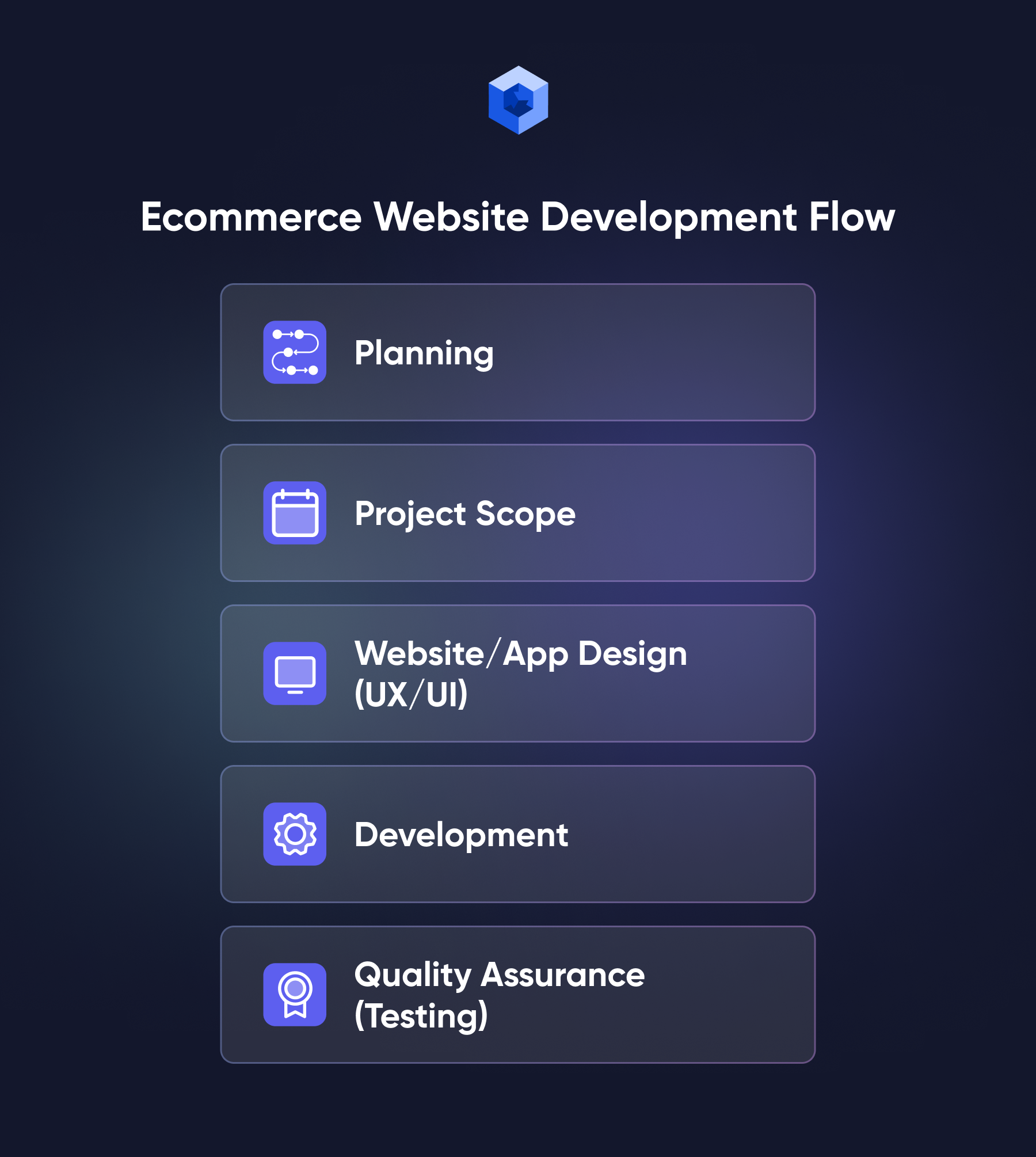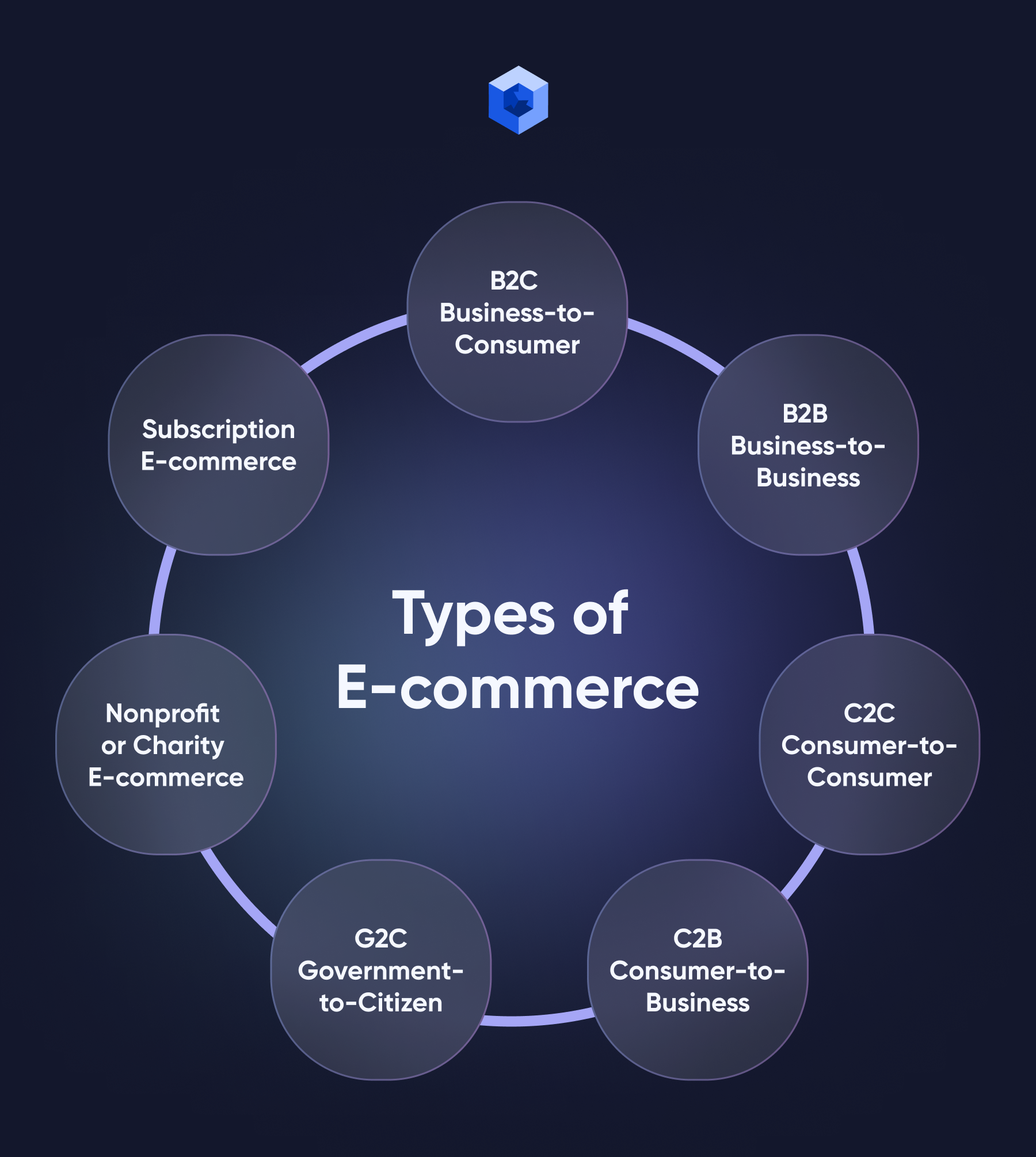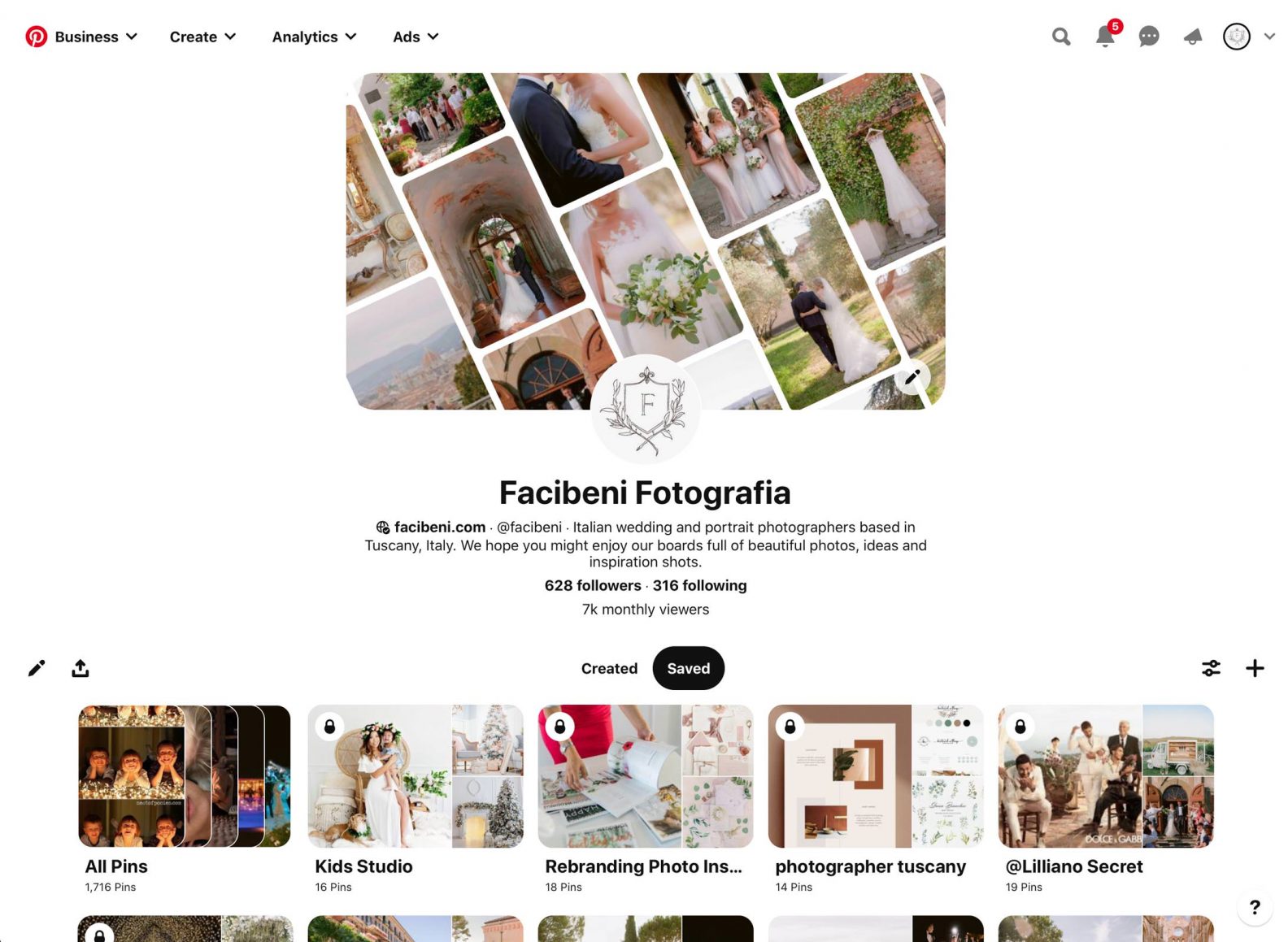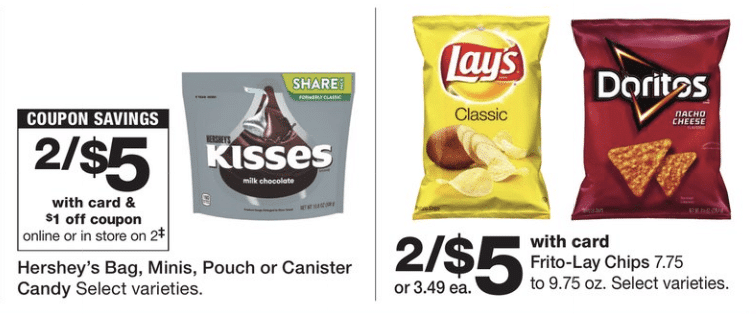The global e-commerce landscape has undergone rapid growth, with online retail platforms surging from 9.2 million in 2019 to a staggering 26.5 million by 2023 (as reported by Markinblog).
In this ever-expanding digital realm, the United States stands as a major player, boasting a substantial 13,982,500 e-commerce sites. In 2022, the world of e-commerce saw retail sales soar to an estimated 5.7 trillion U.S. dollars, demonstrating its economic might.
What is E-commerce Website Development?
E-commerce website development involves creating and enhancing online platforms for businesses to sell products or services over the Internet.
For entrepreneurs and decision-makers, diving into technical intricacies isn't always necessary. Instead, focusing on broader goals, desires, and vision is paramount. The following is an outline of the website development workflow that you should understand before collaborating with a professional software development agency.

Types of E-commerce Websites
Business-to-Consumer (B2C): B2C e-commerce sites are the most common type, facilitating transactions between businesses and individual consumers. Notable examples include online retail giants like Amazon, eBay, and fashion brand websites. These platforms aim to directly sell products or services to end consumers, emphasizing user-friendly interfaces, secure payment gateways, and personalized shopping experiences.
Business-to-Business (B2B): B2B e-commerce sites streamline transactions between businesses. Examples include Alibaba, Grainger, and industrial equipment suppliers' websites. These platforms often incorporate features like bulk ordering, account management, and procurement system integration, prioritizing efficiency and custom pricing for bulk orders.
Consumer-to-Consumer (C2C): C2C e-commerce platforms enable individuals to buy and sell products or services directly to other individuals. Examples include eBay, Craigslist, and peer-to-peer marketplace apps. Trust and user ratings are pivotal in C2C platforms, which act as intermediaries, allowing people to create listings, negotiate prices, and complete transactions.
Consumer-to-Business (C2B): In C2B e-commerce, individual consumers offer products or services to businesses. Platforms like Upwork and Fiverr exemplify this model, empowering individuals to set prices and offer their skills or products to businesses, aligning with the gig economy's rise in popularity.
Government-to-Citizen (G2C): G2C e-commerce sites, operated by government agencies, provide services and information to citizens. These sites enhance citizen-government interactions by offering online services, reducing paperwork, and improving accessibility.
Nonprofit or Charity E-commerce: Nonprofits utilize e-commerce sites to sell merchandise or accept donations to support their causes. Websites of nonprofit organizations, charity foundations, or educational institutions combine e-commerce functionality with a focus on raising funds or awareness for social or charitable causes.
Subscription E-commerce: Subscription e-commerce models involve offering products or services regularly. Examples include subscription boxes for beauty products (e.g., Birchbox), streaming services (e.g., Netflix), or software subscriptions (e.g., Adobe Creative Cloud). These websites prioritize customer retention, offering personalized recommendations and easy subscription management.

What makes an e-commerce site successful?
Fast Loading Speed
An optimal page load time falls within the range of 0 to 3 seconds, with up to 3 seconds generally considered acceptable. However, load times exceeding 3 seconds raise the probability of visitors exiting your website.
What makes a website fast or slow?
Website speed depends on factors such as efficient code, optimized images, and fast servers. Minimizing file sizes and reducing server response times contribute to faster load times, ensuring a better user experience.
Easy Checkout Process
Streamlined, one-click, or guest checkout options reduce cart abandonment rates and simplify the buying process.
Contact Page with Multiple Contact Options
By offering various communication channels like phone, email, live chat, and social media, businesses can accommodate diverse customer preferences, providing quicker and more convenient ways to address inquiries or issues. This not only fosters trust and engagement but also increases the likelihood of successful conversions and customer satisfaction.
Helping your customers easily find what they're looking for
The 3Cs of e-commerce will come in handy: connection, context, and content.
- Connection
Know your customers. To do this, use Google Analytics, where you can track which country your customers are from, and how they make decisions before buying something. Be sure to track feedback and data analytics.
- Context
AI is being talked about everywhere, but this is where predictive analytics comes into play. Don't bombard your visitors with impersonal recommendations. Instead, learn from Amazon, Netflix, or Sephora. Our designers and web developers know the design and data analysis patterns for your personalized user experience, so if you don't want to think about it, you can take a look at one of our many e-commerce cases here.
- Content
Content in e-commerce rests on one essential pillar — On-page SEO.
On-page SEO refers to the practice of optimizing individual web pages to improve their search engine rankings and attract more organic (non-paid) traffic. It involves various strategies and techniques that focus on optimizing the content and HTML source code of a web page to make it more attractive to search engines like Google.
According to a survey by Moz, 70-80% of users ignore paid ads and only focus on organic search results.
So the main focus should be on the positional keywords on the site, and the correct semantics of the site, which includes the queries of the target audience. A simple example is to use LSI phrases or use the body to find queries by keywords.
Additionally, consider user-generated content, such as customer reviews and testimonials, which can build trust and authenticity. For example, our client iS CLINICAL on the website shows reviews in well-known magazines, feedback from customers about their struggle with acne, and how their products helped them.

Consumer Behavior Psychology in E-commerce Content
- Goal Gradient Effect: This psychological principle suggests that people are more motivated to complete a task as they perceive themselves getting closer to a goal. In eCommerce, you can apply this by offering rewards or bonuses for reaching certain purchase thresholds. For example, "Spend $50 more to earn a $10 discount."
Starbucks employs the goal gradient effect by offering rewards for frequent purchases. They have a tiered loyalty program where customers earn stars for each purchase. As customers accumulate more stars, they move closer to higher reward levels, motivating them to make additional purchases to reach the next tier.

2.Endowment Effect: This concept involves the idea that people tend to overvalue items they own. In eCommerce, creating lists of collections (e.g., clothing categories) and allowing users to save items to these lists is akin to Instagram's saved posts feature. Users feel a sense of ownership and attachment to their collections, increasing the likelihood of future purchases.
Pinterest allows users to create boards and save pins (images and ideas) to these boards. This concept taps into the endowment effect as users feel a sense of ownership and attachment to their curated collections of pins, making them more likely to revisit the platform and take action on their saved items.

3.Zeigarnik Effect: The Zeigarnik Effect suggests that people remember uncompleted or interrupted tasks better than completed ones. In eCommerce, this principle can be applied by using progress bars or reminders to encourage users to complete their purchases. For instance, "Your cart still has items waiting for checkout.”
Booking.com effectively utilizes the Zeigarnik effect by displaying a message like "Hurry, only 1 room left!" on hotel booking pages. This creates a sense of urgency, making users more likely to complete their booking before losing out on the last available room.
4.Anchoring Bias: People often rely heavily on the first piece of information they encounter when making decisions. In eCommerce, setting a higher initial price for a product (anchor) and then displaying a discounted price can influence customers to perceive it as a better deal, even if the discount is modest. For example, showing "Originally $99, now $79" can make $79 seem like a steal.
Amazon often uses the anchoring bias by showing a higher "list price" alongside the current price, highlighting the perceived discount. For instance, they might display "List Price: $129, Price: $99" to make the $99 price seem like a better deal compared to the original price.

5.Authority Bias: Collaborating with influencers or industry experts to curate lists of products can boost credibility and trust in your eCommerce platform. Users are more likely to make a purchase when they see recommendations from authoritative figures they admire.
Sephora collaborates with beauty influencers and makeup artists to curate collections of recommended products. These influencers have authority in the beauty industry, and their product selections are featured on Sephora's website, increasing customer trust and the likelihood of purchases.
6.Loss Aversion: People are more motivated by the fear of losing something than the prospect of gaining it. In eCommerce, emphasizing limited-time offers or low stock quantities can instill a sense of urgency, encouraging users to purchase before the opportunity is gone.
Ticketmaster often emphasizes limited-time offers and low ticket availability to tap into loss aversion. They display messages like "Only 2 tickets left at this price!" to encourage users to make a purchase promptly to avoid missing out on the desired event.
7.Social Proof: Displaying user reviews and ratings can significantly impact purchasing decisions. Seeing positive feedback from other customers builds trust and confidence in your products and services.
TripAdvisor is a well-known travel website that provides user-generated reviews and ratings for hotels, restaurants, and attractions worldwide.

CMS Website Development Services
A content management system (CMS) is an application that is used to manage content, allowing multiple contributors to create, edit and publish.
E-commerce websites need CMS for efficient content and product management, user-friendly interfaces, consistent branding, SEO optimization, version control, security, scalability, and seamless integration of third-party tools and features. A CMS simplifies website management reduces reliance on technical expertise, and supports growth in the dynamic e-commerce environment.
The advantage of a CMS lies in its ability to utilize pre-designed templates for adding new products, services, blog pages, banners, and more, eliminating the need to create everything from the ground up. Once your website theme is in place and configured properly, even team members without technical expertise can independently publish content.
Types of Content Management Systems (CMS)
Content Management Systems (CMS) can broadly be categorized into two types: open source and custom/proprietary. If you have a preference for a specific CMS or require guidance on choosing one, we can always help. But to recognize your preferences, feel free to explore the comparison table.

What does an eCommerce web developer do?
An e-commerce web developer specializes in creating, maintaining, and optimizing online stores, handling front-end design, back-end development, database management, and payment gateway integration. They prioritize security, SEO, and responsive design, offering technical support for the entire online shopping experience.
How to choose the best website development services company?
Selecting the right website development services company is a pivotal step in ensuring the success of your project. Taking the time to research and evaluate potential partners will lead you to a dependable and capable team that can transform your website vision into reality.
- Evaluate Your Needs
Start by comprehending the specific requirements, objectives, and budget for your project. This foundational step sets the stage for the rest of your decision-making process.
2.Check Portfolio
Examine the portfolios of the shortlisted companies to gauge the quality of their work. Seek projects within their portfolio that align with your industry, design preferences, and technical prerequisites. You can often find top-rated agencies listed on platforms like Clutch, TechBehemoths, or DesignRush. For instance, our team at Movadex ranks among the best in San Francisco, New York, and Boston.
3.Cost Transparency
Request comprehensive cost estimates from each company, including itemized breakdowns of expenses. Consider various pricing models, such as cost per project or per hour, which are common in the software development services industry.
4.Communication
Assess the company's communication skills, emphasizing their ability to grasp and align with your vision. Proficiency in English, ideally at a C1 level, is often crucial for effective collaboration.
5.Support and Maintenance
Clearly define expectations regarding response times and procedures for handling issues or implementing updates. Ensure that the company can meet your project's schedule and deadlines.
6.Compare and Decide
Compile your evaluation criteria and make an informed decision on the agency that best suits your needs. Once you've selected your partner, you can begin collaborating on your project.
If you are presently in search of a web development agency, we invite you to consider our services at Movadex. With six years of experience and a track record of empowering over 200 projects across diverse sectors such as e-commerce, sustainability, fintech, aviation, KYC, and healthcare, we specialize in revolutionizing digital products and services. Learn more about our work here, and don't hesitate to reach out to us for a consultation here. We look forward to assisting you with your web development needs.




